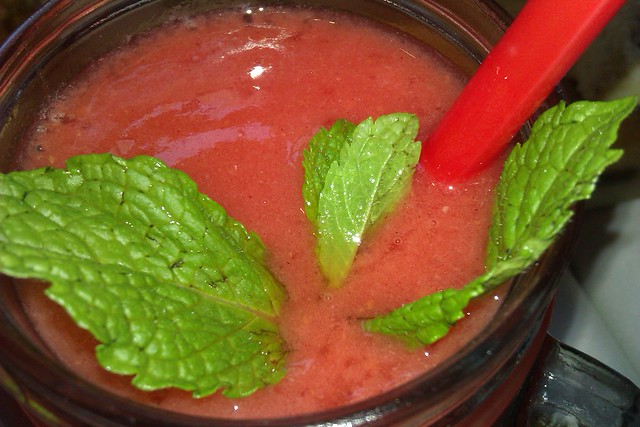Whether a minor ache, pounding pain or nasty migraine, headaches are no fun. But before you start popping pills, try these natural remedies. They’re simple recommended ways to reduce suffering now and stay headache-free in the future
What are Migraines?
According to the National Headache Foundation, more than 29.5 million Americans have migraines. Symptoms of migraine may include:
· Moderate to severe pain on one or both sides of the head
· Pulsating or throbbing pain
· Pain worse with physical activity
· Nausea with or without vomiting
· Sensitivity to light or sound
Approximately 20 percent of people with migraines experience what's called an aura prior to the migraine. Symptoms of an aura include flashes of light, zig zags, or blind spots in your vision or tingling in one arm or leg.
Headaches can be painful, worrisome and downright debilitating. But before you head for the medicine cabinet, why not add some natural remedies to your pain-relief arsenal? They’re more effective than you might expect.
“Many women who suffer from headaches aren’t aware of the various alternative remedies available to them,” says Brian Grosberg, M.D., director of the headache fellowship program at Montefiore Headache Center in Bronx, New York.
Some are immediate solutions to use when your head is pounding, while others are meant to head off headaches long term.
Of course, if you suffer from frequent or severe headaches, you should see your doctor. But for occasional pain, the following 14 treatments can help.
1. Apply an ice pack or Hot Compress
Ice pack - This tried-and-true method – also known as cryotherapy – is a proven way to dull headache pain. Experts suspect that the cold helps constrict blood vessels around the scalp and slows the rate at which nerves transmit pain signals.
Place the ice pack over areas of the most intense pain as well as the upper neck, advises osteopath Frederick Freitag, D.O., a member of the National Headache Foundation’s board of directors.
You can also buy gel packs or use a bag of frozen peas or take a washcloth and place under cold water or put wet washcloth in freezer or fridge.
Hot Compress - Take a wet washcloth and place in microwave for a few seconds. This works wonders for me, once I place the steamy hot washcloth on my face and head I can just feel the pain subside.
2. Kick the butts.
With each puff of a cigarette, you’re breathing in at least 4,000 chemicals and raising your risk for heart disease, stroke, aneurysm and cancer.
Smoking also does other nasty things, such as increasing blood pressure, decreasing circulation, inflaming sinus cavities and nasal passages, and shrinking blood vessels, which all add up to headaches,
Even secondhand smoke can cause the brain's blood vessels to narrow.
So if you or someone close to you smokes, call 1-800-QUITNOW (1-800-784-8669) to reach your state’s quit line.
3. Have a snack.
When you develop a headache during a long, pressure-filled day, it’s easy to blame stress.
But the reason could be that you didn't eat.
Your brain runs on two things – glucose, which comes from food you eat, and oxygen.
“When it doesn't get enough of either, the brain fires up pain-sensitive neurons to tell you its needs aren't getting met,” Freitag explains.No matter how busy you are, aim to eat something at least every 4-6 hours. (Try 5-6 mini-meals instead of three big ones.)
Choose meals that combine complex carbohydrates with protein, which take longer to digest than a candy bar.
Good snacks for headache prevention include steel-cut oatmeal with low-fat milk or turkey and whole-wheat crackers.
Omega 3-fortified eggs: Rich in omega 3 fats, these specialized eggs reduce the inflammation thought to cause migraines by restricting the blood vessels in your temples.
Beans: Legumes are loaded with magnesium; a deficiency in this mineral has been linked to migraines.
Skim milk: Milk is full of riboflavin, a B-vitamin that plays a role in energy production at the cellular level; lack of cellular energy is thought to trigger migraines.
Ground flaxseeds: These tiny seeds are a big source of the essential omega 3 fats that reduce inflammation.
Stuff yourself with spinach.
Popeye knew the secret to warding off headaches: Eat plenty of spinach, which is high in the mineral magnesium, which prevents blood vessels from going into spasms. Spinach has been shown to help decrease blood pressure, prevent hangovers and may help to alleviate headaches, Try using spinach leaves instead of lettuce for a headache-preventing power salad. This summer salad is packed with headache-soothing foods: Toss together 2 cups spinach leaves, 3/4 cups cubed watermelon, 1/2 cup chopped dried apricots and 2 Tbsp chopped walnuts or almonds, and drizzle with raspberry vinaigrette.
As many as half the people who experience acute migraine attacks have low blood levels of magnesium, says Alexander Mauskop, M.D., director of the New York Headache Center in New York City.
Other magnesium-rich foods include whole grains, tofu, seeds and avocados. Magnesium is effective for menstrual-associated migraines and migraines associated with auras.
The downside: Magnesium may cause diarrhea, if you take too much. If you take pills take no more than 400 to 600 milligrams per day.
Baked Potato
The side you love with dinner could help soothe your aching head, especially if your headache is alcohol-related, says Erin Palinski, RD, a registered dietician in private practice in New Jersey. “Since alcohol is a diuretic, it can not only cause dehydration, but also cause you to lose electrolytes such as potassium,” she says. “Eating potassium-rich foods can help to alleviate hangover-related headaches.” Surprisingly, a baked potato (with the skin) is one of the most impressive sources of potassium, containing a whopping 721 mg. By comparison, a banana serves up 467 mg.
Watermelon
Dehydration is a major cause of headaches, explains Stella Metsovas, BS, CN, a nutritionist in private practice in Laguna Beach, California. So instead of popping a pain pill next time your head throbs, consider reaching for water-rich foods, like watermelon. “The natural water contained in both fruits and vegetables contains essential minerals, like magnesium, that are key in headache prevention,” she says. Try this tasty, hydrating watermelon smoothie: In a blender, combine 2 cups seeded watermelon chunks, 1 cup cracked ice, ½ cup plain yogurt, a drizzle of honey and ½ tsp grated ginger. Blend and enjoy. (Bonus: The ginger can help ease headache-induced nausea symptoms!) Other foods with high water content include berries, cucumber, melon, soups, oatmeal, tomatoes and lettuce.
Coffee
Java has been a folk remedy for headaches for centuries, but does it really work? Yes, but in moderation, says Palinski. “Alcohol can cause blood vessels to expand, exasperating headaches,” she explains. “Since the caffeine in coffee is a vasoconstrictor, it can help alleviate a headache by helping to reduce the size of the blood vessels.” But hold off on the triple venti. Too much coffee could make matters worse. “Caffeine is also a diuretic, which can increase dehydration and increase the severity of a headache,” adds Palinski. “The bottom line: One cup of coffee may be helpful for decreasing hangover-related headaches, but drinking coffee throughout the day would not be the best choice for curing a headache.”
Whole-Grain Toast
Low-carb dieters beware: Too little carbohydrates and you might bring on a headache. “When you follow a low-carbohydrate diet, you begin to deplete glycogen stores, which are a main source of energy to the brain,” says Palinski. “This also causes an increase in fluid losses from the body, which can trigger dehydration. By reducing energy to the brain and causing dehydration, these low-carbohydrate diets can trigger headaches.” When one hits, consider reaching for healthy carbs, such as those found in whole-wheat bread, oatmeal, fruit or yogurt. Bonus: A healthy boost of carbs may also improve your mood, as they help your body to release serotonin, the feel-good hormone.
Almonds
According to past research, magnesium, found in almonds, may protect your body from the brunt of a headache by relaxing blood vessels. Migraine sufferers may also experience relief by following a diet rich in magnesium, some experts believe. “To increase your magnesium intake, try consuming magnesium-rich foods such as bananas, dried apricots, avocados, almonds, cashews, brown rice, legumes and seeds,” suggests Palinski.
Spicy Salsa
Can you say caliente? It may sound unusual, but spicy foods such as salsa and hot peppers may help you snap back from a headache faster. “Depending on the type of headache, spicy foods may be helpful,” says Palinski. “If a headache is due to sinus congestion, spicy foods may help to decrease congestion and open the airways, helping to decrease pressure and the accompanying headache.”
Yogurt
When your head is pounding, your body may be calling out for calcium, says Metsovas. “The brain depends on calcium to function efficiently,” she adds. “Make sure you are consuming calcium-rich foods, like fat-free plain Greek yogurt, which is a great source of calcium, with no added sugars and beneficial probiotics for your gut.”
Sesame Seeds
Sprinkle them on salads, in oatmeal or on top of soups and stir-fries. Why? These tiny seeds pack a big nutritional punch. “Sesame seeds are rich in vitamin E, which may help to stabilize estrogen levels and prevent migraines during your period,” says Palinski. “It also improves circulation, which helps prevent headaches.” Bonus: Sesame seeds are also rich in magnesium, which may give them added headache-preventing power.
4. Press pain away.
Acupressure is an ancient healing art that you can do yourself by using fingertips to press key points, says Michael Seidman, M.D., medical director for Henry Ford Health System's Center for Integrative Medicine in Detroit.
For a general headache, use your thumb and index finger to squeeze the flesh between your other hand’s thumb and index finger, about half an inch in from where they connect.
Squeeze gently and massage in small, circular motions for one to two minutes. Switch hands and repeat.
(Don’t do this during pregnancy, because it’s also thought to stimulate uterine contractions.)
Another solution is to rub your temples or your head where you feel the most pain.
You can also try tying a headband around the head, a practice that's been done since ancient times
Get someone to give you a back or head massage.
5. Gulp a glass of water.
Dehydration is a common trigger for migraines and other headaches.
Without enough water, blood becomes thicker and doesn’t flow as easily, while blood vessels narrow, reducing the brain’s oxygen supply.
So when your head hurts, down a big glass of water to hydrate yourself, Freitag suggests.
In general, try to drink at least eight 8-ounce glasses of water a day. And add in plenty of water-filled fruits and veggies like cucumber, celery and watermelon.
6. Stop taking headache medicine.
Some pain relievers may actually make headaches worse.
Overusing over-the-counter remedies with caffeine and antihistamines or prescription narcotics can interfere with the brain’s pain-regulation messages and lower your pain threshold, Grosberg says. And too-frequent use of everyday drugs such as aspirin or acetaminophen can result in “rebound headaches” when you stop.
If you take headache medicine more than two days a week, see your doctor about how to wean yourself.
7. Banish some foods.
Certain foods contain an amino acid, tyramine, that can trigger migraines by constricting and then expanding blood vessels, Freitag says.
These include aged cheeses such as cheddar, brie, blue, Parmesan and Swiss.
Luncheon meats such as bologna and salami contain both tyramine and food additives called nitrates, which increase blood flow to the brain in some people.
Leftovers can sometimes develop tyramine as they age – even foods that would otherwise be tyramine-free, such as hamburger or shrimp.
If you think your diet may be the culprit, keep a headache diary to see what foods set them off.
8. Cut out diet soda.
Sugar-free products may help keep your waistline slim, but they may also make your head hurt.
Although the link is controversial, a 1995 University of Washington study found that people were slightly more likely to get headaches on days when they consumed the artificial sweetener aspartame.
If you drink diet soda and have headaches, try abstaining for a while to see if that helps.
9. Go for a walk.
Regular exercise heads off headaches by lowering stress levels and boosting natural pain-killing chemicals known as endorphins, Freitag says. It can also help you sleep.
Aim for 30-45 minutes of brisk physical activity, 3-4 days a week.
Unfortunately, exercise can also cause headaches for some people.
If you occasionally get one during or after workouts, make sure you’re eating and drinking enough and that you aren’t exercising too vigorously for your fitness level. If the headaches persist, see your doctor.
10. Get your zzz’s.
Better sleep habits can sometimes head off a migraine or tension headache.
“Sleep is the ‘control-alt-delete’ toggle for your brain’s restart,” Freitag says.
In a 2006 University of North Carolina study, women who took steps to get eight hours of sleep each night had fewer migraines, and those they had were less intense.
11. Try some butterbur.
The herb butterbur (Petasites hybridus) is a shrub-like plant that grows in northern Asia, Europe, and parts of North America. Extracts made from the herb have been used to treat migraines, stomach cramps, coughs, allergies, and asthma.
Several studies suggest that butterbur helps to prevent migraines. The largest study involved 245 people with migraine took either butterbur extract (50 or 75 milligrams twice a day) or a placebo. After four months of treatment, butterbur, 75 milligrams twice a day but not 50 milligrams twice a day, was more effective than placebo for migraines. Side effects were mild and included mild digestive complaints, predominantly burping.
Side effects of butterbur may include indigestion, headache, fatigue, nausea, vomiting, diarrhea, or constipation. Pregnant or nursing women, children, or people with kidney or liver disease should not take butterbur.
Butterbur is in the ragweed plant family, so people who are allergic to ragweed, marigold, daisy, or chrysanthemum should not use butterbur.
The raw herb as well as teas, extracts, and capsules made from the raw herb should not be used because they contain substances called pyrrolizidine alkaloids that can be toxic to the liver and kidneys and may cause cancer.
It is possible to remove the pyrrolizidine alkaloids from butterbur products. For example, in Germany, there is a safety limit to the level of pyrrolizidine alkaloids allowed in butterbur products. The daily recommended dose cannot exceed one microgram per day. Some studies have recommended taking no more than 400 to 600 milligrams per day.
13. Pat on some peppermint.
Peppermint has long been used as an alternative headache treatment. According to a 2007 research review in American Family Physician, dabbing a preparation of 10% peppermint oil on the forehead can significantly reduce headache intensity after 15 minutes.
You can buy peppermint oil in many health-food stores. Gently rub a few drops into your forehead, temples, and back of the jaw and neck when your head is pounding – but keep it away from eyes to avoid irritation.
14. Picture less pain.
An imagination technique known as guided imagery can relieve headaches, Seidman says.
Try this: Close your eyes, breathe deeply and relax. Imagine that the headache is a liquid that fills a cup – the more painful the headache, the bigger the cup. Picture it as clearly as you can.
Now, in your mind, pour the headache pain into a slightly smaller cup, but don’t let any liquid overflow. Then again, pour it into a slightly smaller cup. Continue until you can barely see it.
Bit by bit, you should feel pain fade.
15. Shower
Sometimes the hot water running on your head will help soothe the pain.
16. Hot Tea
Drink it as hot as I can because it works better that way. Chamomile will help to soothe the pain.
17: Caffeine
This goes along with the tea remedy, of course. Caffeine is a double-edged sword – it can help and hinder headaches. Caffeine can restrict blood vessels, it can lessen pain, it’s a constituent of some pain over-the-counter pain medicines, but it can also trigger headaches for some people, If someone uses caffeine excessively, it can cause a rebound headache, making existing headaches worse.
18. Q-tip
Take a Q-tip, put it in your nose and gently rub. There are nerve endings in your nose that are connected to your head which is why you may feel some relief.
19. Breathe
Take some deep breaths. It will take several deep breaths to feel some relief but it does work. This basically causes you to relax and stress is a trigger for migraines.
Also try yoga.
18. Vitamin B2 (Riboflavin)
In doses of 400 milligrams a day, vitamin B2 can also act as a preventative for migraines, Grosberg said. It can cause some people to urinate more frequently or have darker urine, so the dosage may have to be adjusted.
19. Eat ginger or take ginger capsules
Keep ginger handy as a medicinal and culinary herb. Ginger, with its strong flavor, gives flavor to Asian and Indian dishes. It has a long history as a safe, healing plant. Recent research suggests ginger may help reduce pain. Use fresh ginger if possible, for greater potency. You can add it to drinks, stir-fried food, soups or make it into a tea. You can also try essential oil of ginger in an aromatherapy diffuser.
Common Ginger
The ginger commonly found in your local supermarket is Zingiber officinale. Ginger is a light-brown root, or rhizome. You peel the skin off and use the slightly fibrous inside. Ginger is a folk remedy for pain, colds and motion sickness. Ginger also has anti-inflammatory properties, note Vadim Dedov and colleagues in the November 2002 issue of the "British Journal of Pharmacology."
Pinecone Ginger
Pinecone ginger, a relative of common ginger, is a traditional Hawaiian remedy for headaches. An article in "Evidence-Based Complementary and Alternative Medicine" in March 2011 reviewed the medicinal effects of pincone ginger, also known as Zingiber zerumbet. This plant grows in parts of the Pacific and Asia. It contains the chemical zerumbone. Experiments on this plant indicate it has anti-inflammatory properties and may help reduce your headache pain.
Stress Headaches
Tension or stress headaches result in moderate pain, usually on both sides of your head. Elizabeth Loder of the Division of Headache and Pain and Harvard Medical School in Boston and Paul Rizzoli of the Graham Headache Center in Boston state that this type of headache is likely from overstimulated nerve cells in muscles near your head. There could be a genetic predisposition and stress can make matters worse. However, the cause of these headaches is not certain.
Gingerols
Gingerols are the chemicals in common ginger responsible for its medicinal effects. According to Dedov and colleagues, gingerols affect a particular pain receptor known as VR1. They are agonists of this receptor, which means they stimulate VR1 neurons. Dedov notes there are many VR1 receptors in your brain stem. This might explain why ginger helps relieve nausea, Dedov notes. Thus, there is a sound physiological basis for suggesting ginger could help headaches as well. So the next time you are suffering from a stress headache, give ginger a try.
20. Feverfew
The herb feverfew (Tanacetum parthenium) has been used for centuries as a folk remedy for headache, migraine, arthritis, pain, and fever in Europe. It became especially popular in England in the 1980s as an alternative to conventional drugs for migraines.
Several studies have evaluated the effectiveness of feverfew for the prevention and treatment of migraines. For example, one study examined the use of a feverfew extract or a placebo in 170 people with migraines. There was a significant decrease in migraine frequency with feverfew, which decreased by 1.9 migraines per month, compared to the placebo, which decreased by 1.3 migraines per month.
Not all studies have shown that feverfew is effective, however. A critical review of five studies on feverfew and migraines, involving a total of 343 people, concluded that results were mixed and did not convincingly establish that feverfew was effective for preventing migraine.
Side effects of feverfew may include abdominal pain, gas, diarrhea, nausea, vomiting, and nervousness. People with allergies to chamomile, ragweed, or yarrow should not take feverfew. Feverfew may increase bleeding time, so it should not be taken by people with bleeding disorders or two to three weeks before or after surgery. The safety of feverfew in pregnant or nursing women or children has not been established.
Feverfew may interact with "blood-thinning" medications, such as aspirin and warfarin (Coumadin) and non-steroidal anti-inflammatory drugs (NSAIDs). People taking these medications should consult a healthcare practitioner before taking feverfew.
If all else fails and you just can't take the pain any longer, a visit to the Emergency Room may be needed. You may have something more serious going on or the hospital can help your migraine with something stronger. Of course, if you have consistent migraines or headaches, you should consult your physician. They may want to run some testing just to make sure there isn't another, more serious cause for your migraines.
Whether you try one or all of these at-home remedies, you should still keep a headache diary to monitor what works and what doesn't, and what triggers your headache. This will assist your doctor in treating you.
References
http://www.lifescript.com/health/centers/migraine/tips/foods_that_fight_migraines.aspx By Leslie Pepper, Special to Lifescript
Published June 26, 2012
The right diet can help manage, treat and even stop migraine headaches. In her book Joy Bauer’s Food Cures (Rodale, 2007),
http://www.foxnews.com/story/0,2933,530388,00.html
11 Home Remedies for Migraine Headaches
Published July 07, 2009FoxNews.com
http://www.lifescript.com/health/centers/migraine/tips/natural_cures_to_halt_that_headache.aspx?p=1
By Leslie Pepper, Special to LifescriptPublished June 26, 2012
"Evidence-Based Complementary and Alternative Medicine"; Zingiber zerumbet (L.) Smith: A Review of Its Ethnomedicinal, Chemical and Pharmacological Uses; N. J. Yob et al.; March 2011
"British Journal of Pharmacology"; Gingerols: A Novel Class of Vanilloid Receptor (VR1): Agonists; Vadim N Dedov et al.; November 2002
"British Medical Journal"; Tension-Type Headache; Elizabeth Loder and Paul Rizzoli; January 2008
http://www.livestrong.com/article/497073-is-ginger-good-for-relieving-stress-headaches/#ixzz26qih4fi8
http://www.womansday.com/health-fitness/conditions-diseases/9-foods-that-can-help-soothe-a-headache-108253
Read more: Foods That Help Headaches - Foods for Headache Relief - Woman's Day
http://altmedicine.about.com/cs/headachemigraine/a/Migraine.htmDiener HC, Pfaffenrath V, Schnitker J, Friede M, Henneicke-von Zepelin HH. Efficacy and safety of 6.25 mg t.i.d. feverfew CO2-extract (MIG-99) in migraine prevention--a randomized, double-blind, multicentre, placebo-controlled study. Cephalalgia. 25.11 (2005): 1031-1041.
Lipton RB, Gobel H, Einhaupl KM, Wilks K, Mauskop A. Petasites hybridus root (butterbur) is an effective preventive treatment for migraine. Neurology. 63.12 (2004): 2240-2244.
Peikert A, Wilimzig C, Kohne-Volland R. Prophylaxis of migraine with oral magnesium: results from a prospective, multi-center, placebo-controlled and double-blind randomized study. Cephalalgia. 16.4 (1996): 257-263.
Pfaffenrath V, Diener HC, Fischer M, Friede M, Henneicke-von Zepelin HH; Investigators. The efficacy and safety of Tanacetum parthenium (feverfew) in migraine prophylaxis--a double-blind, multicentre, randomized placebo-controlled dose-response study. Cephalalgia. 22.7 (2002): 523-532.
Pfaffenrath V, Wessely P, Meyer C, Isler HR, Evers S, Grotemeyer KH, Taneri Z, Soyka D, Gobel H, Fischer M. Magnesium in the prophylaxis of migraine--a double-blind placebo-controlled study. Cephalalgia. 16.6 (1996): 436-440.
Pittler MH, Ernst E. Feverfew for preventing migraine. Cochrane Database Syst Rev. 2004;(1):CD002286.
Wang F, Van Den Eeden SK, Ackerson LM, Salk SE, Reince RH, Elin RJ. Oral magnesium oxide prophylaxis of frequent migrainous headache in children: a randomized, double-blind, placebo-controlled trial. Headache. 43.6 (2003): 601-610.







